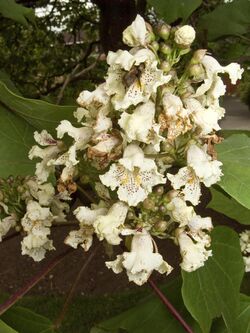Biology:Catalpa ovata
| Catalpa ovata | |
|---|---|

| |
| Flowers | |
| Scientific classification | |
| Kingdom: | Plantae |
| Clade: | Tracheophytes |
| Clade: | Angiosperms |
| Clade: | Eudicots |
| Clade: | Asterids |
| Order: | Lamiales |
| Family: | Bignoniaceae |
| Genus: | Catalpa |
| Species: | C. ovata
|
| Binomial name | |
| Catalpa ovata | |
| Synonyms[2][3][4] | |
|
Catalpa kaempferi Siebold & Zucc. | |
Catalpa ovata, the yellow catalpa[1][5] or Chinese catalpa[1] (Chinese: 梓; pinyin: zǐ), is a pod-bearing tree native to China . Compared to C. speciosa, it is much smaller, typically reaching heights between 20 and 30 feet (6 and 9 m). The inflorescences form 4–10-inch-long (100–250 mm) bunches of creamy white flowers with distinctly yellow tinging; individual flowers are about 1 inch (25 mm) wide. They bloom in July and August.[5] The leaves are very similar in shape to those of Paulownia tomentosa, having three lobes (two are abruptly truncated on either edge, with a third, central, slightly acute, pointed lobe forming the leaf apex), and are darkly green.[5][6] Fruits are very narrow, foot-long pods.[5]
Although native to the more temperate provinces within China (Anhui, Gansu, Hebei, Heilongjiang, Henan, Hubei, Jiangsu, Jilin, Liaoning, Nei Monggol, Ningxia, Qinghai, Shaanxi, Shandong, Shanxi, Sichuan, Xinjiang),[1] C. ovata is also cultivated in North America and Europe, and has become a parent of Catalpa × erubescens with the American species Catalpa bignonioides.[1][5] It is commonly used to make the undersides of qin.[7]
Gallery
Chemistry
The plant contains dehydro-alpha-lapachone[8] (DAL) which inhibits vessel regeneration, interferes with vessel anastomosis, and limits plexus formation in zebrafish.[9] DAL also controlled the development of the fungi rice blast, tomato late blight, wheat leaf rust, barley powdery mildew and red pepper anthracnose (Colletotrichum coccodes (Wallr) S Hughes). The chemical was particularly effective in suppressing anthracnose.[10]
Other
Referenced in the Zhuangzi.[11]
References
- ↑ 1.0 1.1 1.2 1.3 1.4 Gen. hist. 4:230. 1837 {{citation | mode = cs1 | title = Catalpa ovata | work = Germplasm Resources Information Network (GRIN) | url = | publisher = [[Organization:Agricultural Research ServAgricultural Research Service (ARS), United States Department of Agriculture (USDA) | access-date = December 7, 2009 }}
- ↑ 2.0 2.1 Gen. Hist. iv. 230. Plant Name Details for Catalpa ovata. IPNI. http://www.ipni.org:80/ipni/idPlantNameSearch.do?id=109171-1. Retrieved December 7, 2009. "Notes: =Kaempferi"
- ↑ Abh. Akad. Muench. iv. III. (1846) 142. Plant Name Details for Catalpa kaempferi. 4. IPNI. http://www.ipni.org:80/ipni/idPlantNameSearch.do?id=109163-1. Retrieved December 7, 2009. "Notes: Japon"
- ↑ "Catalpa ovata - G.Don". Plants For A Future. http://www.pfaf.org/database/plants.php?Catalpa+ovata. Retrieved December 7, 2009.
- ↑ 5.0 5.1 5.2 5.3 5.4 Phillips, Roger (1978). Trees in Britain, Europe and North America. Cavaye Place, London, England: Pan Books Ltd.. p. 96. ISBN 978-0-330-25480-9.
- ↑ Phillips, Roger (1978). Trees in Britain, Europe and North America. Cavaye Place, London, England: Pan Books Ltd.. p. 42. ISBN 978-0-330-25480-9.
- ↑ Yeung, Juni (2010). Standards for the Guqin February 2010 Draft. Toronto: Toronto Guqin Society.
- ↑ Dehydro-alpha-lapachone
- ↑ Garkavtsev I, Chauhan VP, Wong HK, Mukhopadhyay A, Glicksman MA, Peterson RT, Jain RK.,"Dehydro-alpha-lapachone, a plant product with antivascular activity." Proc Natl Acad Sci USA. 2011 Jul 12;108(28):11596-601
- ↑ Cho, JY; Kim, HY; Choi, GJ; Jang, KS; Lim, HK; Lim, CH; Cho, KY; Kim, JC (2006). "Dehydro-alpha-lapachone isolated from Catalpa ovata stems: Activity against plant pathogenic fungi". Pest Management Science 62 (5): 414–8. doi:10.1002/ps.1180. PMID 16550502.
- ↑ "Chinese Text Project Dictionary". http://ctext.org/dictionary.pl?if=en&id=2848.
External links
Wikidata ☰ Q1144805 entry
 |




